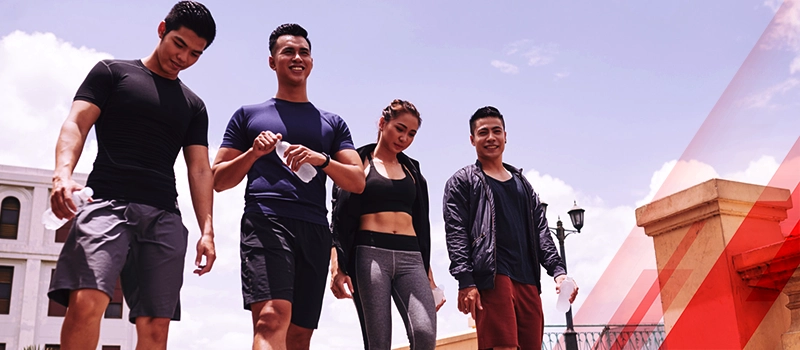Activewear is clothing made for sporting and leisure activities; it combines style, comfort, and function. Activewear is made from durable, comfortable sustainable materials. Until a few years ago, sportswear—which had been used in sports—was the main focus of the apparel industry. The demand for Activewear, which may offer a sense of style, comfort, and flexibility, has increased as a result of rising social activities and active lifestyles.
As more people get drawn to the product's ability to provide sweat-wicking & breathability and improvement of physical movement, the market is expanding significantly. The product helps protect against extreme weather, improves blood circulation, and injury avoidance is helping to increase its usage. As more individuals are participating in fitness activities, the urban population is growing faster than before, which increases product consumption. For example, according to data published by World Bank.Org, the worldwide urban population was estimated to be 55.714 percent in 2019, up from 55.27 percent in 2018.
Unlocking the Key Drivers Shaping the Activewear Market
One of the main aspects influencing the market currently is the rising number of campaigns being run by various organizations across the globe to encourage sports participation. Additionally, more and more green textiles are being used to create sustainable activewear throughout the globe. This is accelerating the market's expansion, along with people's increasing awareness of the advantages of leading healthy lifestyles.
The global market for activewear is anticipated to grow from USD 303.4 billion in 2021 to USD 461.7 billion in 2030, recording a CAGR of 5.8% driven by rising disposable income and customers who are more health concerned. Additionally, a rise in the population's engagement in physical activity among both young and old people fuels demand for sports-related products, fueling market growth.
World Population’s Heightened Health Consciousness Fuels Market Growth
The demand for the product has grown as a result of the expanding number of health-conscious people increasing the number of gym visits in several nations throughout the world. For instance, according to statistics provided by the International Health, Racquet & Sportsclub Association, there were 39,570 gyms in the United States in 2018 and more than 6 billion people visited them.
Along with this, individuals are starting to engage in fitness activities to improve their health in an effort to gain traction. This is due to the growing popularity of fitness apps on technological devices. For instance, according to data from the World Economic Forum released in September 2020, the use of fitness applications increased by 50% in the first half of 2020.
Where Does the Activewear Market Have the Most Potential Globally?
The activewear market share is expected to grow significantly in Asia Pacific. A crucial factor in the expansion of the market is the increasing government expenditure on sports, which has increased demand for the product. For instance, according to information provided by the Economic Times in February 2020, India's government had allocated USD 401.6 million for sports, an increase of USD 7.103 million over the previous year.
The thriving development of sports domains including cricket, which has led to a big population of players both professionally and as a hobby, has also made a significant impact. The Indian Premier League, an Indian cricket league, is predicted to be worth USD 6.8 billion and see a growth rate of 7%, according to additional statistics from the Hindu published in September 2019.
North America is the major contributor to the global activewear market share. The use of the product increased as a result of the region's strong recreational industry growth. To be specific, according to data from the Bureau of Economic Analysis, the recreational economy in the United States contributed 2.2 percent of the country's current dollar GDP, or USD 459.8 billion, in 2019.
Additionally, a sizable percentage of school students who participate in sports fueled demand for the product, which is likely to increase consumption rates. For instance, 7,937,491 high school students participated in sports in the United States in 2018–19, according to data released by the National Federation of State High School Associations.
Is Activewear's High Cost Causing Declining Sales Among Price-Sensitive Consumers?
Consumers are experiencing safety and quality difficulties as a result of the increase in counterfeit products, and major market participants are facing brand damage. For instance, at Virginia's Dulles International Airport in January 2018, Nike discovered counterfeit athletic items valued at more than $50,000. The top activewear market players' sales are dropping as a result of these issues which is hampering the market's overall growth. Additionally, the final product is expensive due to the variable cost of raw materials and the high cost of design. Therefore, sales of activewear among consumers who are price-conscious are dropping due to the high cost of the clothing.
Contrarily, a number of groups, such as the Women's Sports Foundation, Boxgirls, Feminist Majority Foundation, and others, are promoting sports participation and taking steps to empower women, which is expected to open up new potential opportunities for the activewear market.
In the End
The activewear market is being shaped by a combination of factors including the rise of the fitness and wellness industry, the popularity of athleisure wear, and technological advancements in textiles and materials. Brands are responding by investing in innovative solutions that meet the demands of the modern consumer. As the activewear market continues to grow, it will be exciting to see how these dynamic forces will evolve and impact the industry in the years to come.




